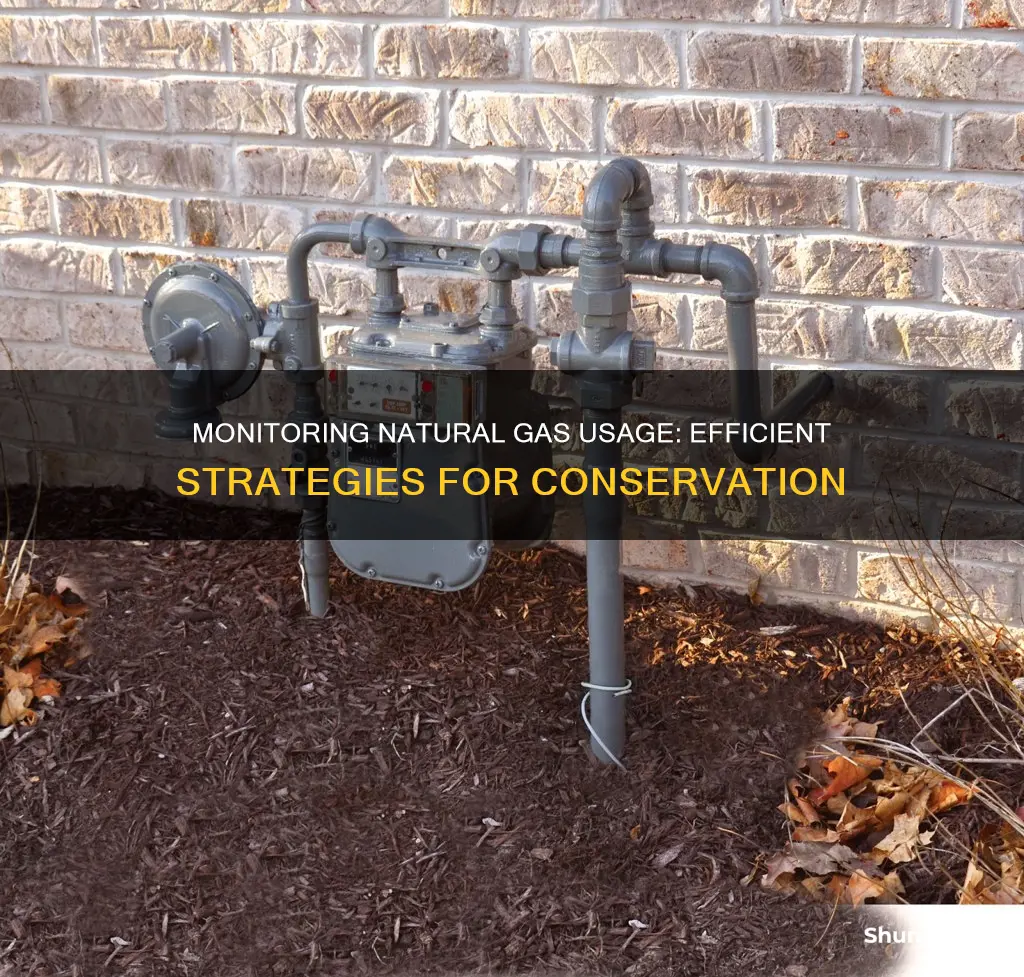
Monitoring natural gas usage is essential for managing energy consumption and costs. While traditional diaphragm gas meters provide mechanical measurements, newer technologies offer more accurate and convenient solutions. Smart gas meters, such as the Prodigi by Cavagna Group, leverage ultrasonic sensors and IoT connectivity to remotely track gas usage. These meters transmit data to management platforms, enabling gas companies to optimize deliveries and supply, while consumers benefit from accurate billing and insights into their consumption patterns. Additionally, devices like the Heat Meter attach to furnaces to track propane, natural gas, or oil usage in real time. With the help of these tools, individuals and businesses can make informed decisions to improve energy efficiency and reduce expenses.
| Characteristics | Values |
|---|---|
| Natural gas measurement unit | Cubic foot |
| Billing unit | Thousands of cubic feet (MCF) or hundreds of cubic feet (CCF) or therm |
| Meter type | Electromechanical |
| Meter working | Driven by the force of the moving gas in the pipe |
| Meter reading | From left to right |
| Meter dials | Hands of adjacent dials turn in opposite directions |
| Meter display | Analogue dials or digital display |
| Gas monitoring devices | Heat Meter, FLOWSIC500, Prodigi |
What You'll Learn

Using a smart meter
Smart meters are an effective way to monitor natural gas usage. They provide accurate and secure monitoring of gas consumption, allowing gas companies to remotely track a customer's consumption and manage their operations efficiently. Smart meters also enable gas companies to invoice customers accurately and eliminate the need for estimated bills, which can be unpredictable.
Smart meters use radio technology to transmit data to a computer, which then sends the information to the gas company. This technology is known as Automated Meter Reading (AMR) and has been implemented by companies such as Peoples Natural Gas, who began installing AMR devices on their meters in 2016.
Smart meters offer several benefits to customers. They provide detailed information about energy usage, allowing customers to make informed choices and reduce costs. For example, you can view your hourly electric and daily gas consumption and compare it to previous periods. Additionally, smart meters enable energy providers to quickly identify outages and resolve service problems without visiting your home.
To read your smart meter, locate the meter fixed to a wall or board, typically in a kitchen cupboard or a box outside your home. The way you take a reading depends on the type of meter. For instance, if your meter has A and B buttons under the screen, press the A button until you see 'METER INDEX' and numbers followed by 'M3'. Write down the number from left to right, ignoring any leading zeroes or decimal points.
Smart meters are a convenient and efficient way to monitor natural gas usage, offering benefits to both customers and gas companies. They provide accurate data, enable better energy management, and streamline billing processes.
Monitoring Data Usage: Tips for Managing Home Internet Plans
You may want to see also

Monitoring heating costs
Monitoring your heating costs can help you understand your energy usage and identify areas where you can save money. Here are some ways to monitor your natural gas usage for heating:
Manual Meter Readings
You can read your natural gas meter yourself to monitor usage. Natural gas is typically measured in cubic feet, and you are billed per thousand cubic feet (MCF) or hundreds of cubic feet (CCF). Alternatively, you may be billed by the therm, which is approximately equal to 100 cubic feet. To read your gas meter, note down the numbers displayed on the dials from left to right. The dials on adjacent meters turn in opposite directions, so be sure to account for that when taking your readings. Compare your readings with the previous month's readings to calculate your usage for that billing period.
Smart Meters
Smart meters are an innovative solution for monitoring natural gas usage. These meters use ultrasonic sensors to measure gas flow and transmit the data electronically to a management platform. This allows gas providers to remotely monitor customer consumption and control the gas flow if needed. Smart meters also benefit consumers by providing accurate data on their actual consumption, helping them understand their usage patterns and pay for only the gas they use. Additionally, smart meters can be integrated with mobile applications, enabling users to track their energy use and compare it with others in the area.
Heat Meter Devices
Devices like the Heat Meter by Y Shape Inc. allow homeowners to track their propane, natural gas, or oil usage in real time. This device attaches magnetically to a furnace or boiler and detects vibrations when the unit's flame ignites. Since most heating systems burn fuel at a constant rate, the Heat Meter can predict energy costs by measuring the duration of the flame. Users can input their home's square footage and make adjustments to their thermostat settings to optimize their energy consumption and costs.
Online Utility Accounts
Many utility companies now provide daily or hourly gas readings online through your online utility account. Services like Snapmeter gather gas usage and billing data directly from your online account, allowing you to visualize your gas usage patterns and identify areas for improvement in energy efficiency. You can also review your natural gas bills, compare monthly costs, and analyze year-over-year variances to make informed decisions about your heating usage.
Ultrasonic Gas Flow Meters
For industrial applications, such as cement plants, ultrasonic gas flow meters like the FLOWSIC500 provide highly precise measurements of natural gas distribution. These meters have no mechanically operated parts, making them reliable and requiring minimal maintenance. They can be integrated into existing measuring stations and are powered by an intrinsically safe power supply or a battery backup.
Monitoring Internet Usage: AT&T's Parental Controls Guide
You may want to see also

Comparing usage to weather
Monitoring your natural gas usage is a great way to keep track of your energy consumption and identify areas where you can improve your energy efficiency. One important factor that can impact your natural gas usage is the weather. Here are some ways you can compare your natural gas usage to the weather:
- Heating Degree Days and Cooling Degree Days: During the heating season, compare your energy use to the number of heating degree days for the same time period. Each degree Fahrenheit below 65°F is counted as one heating degree day. Similarly, during the cooling season, compare your energy use to the number of cooling degree days, where each degree Fahrenheit above 65°F is counted as one cooling degree day. This simple measure will help you understand the effect of weather on your energy needs.
- Monthly Utility Bills: Your monthly utility bills can provide valuable information about your natural gas usage. Ensure that the bills are based on actual meter readings and take note of the time period between readings as it can vary. By comparing your usage during different weather conditions, you can identify trends and make adjustments to optimize your energy efficiency.
- Real-Time Tracking: Devices like the Heat Meter allow you to track your natural gas usage in real time. By attaching to your furnace or boiler and monitoring vibrations and flame ignitions, it can accurately predict energy costs. Combining this data with weather information can help you make informed decisions about your energy use.
- Historical Comparison: Compare your energy usage during a specific weather period with the same time period from the previous year. For example, if you experienced a particularly cold winter, you can analyze how your natural gas usage changed compared to the previous winter. This will help you understand the impact of weather variations on your energy consumption.
- Weather Normalization: Weather normalization techniques can be used to adjust your natural gas usage data based on weather conditions. By comparing your usage to a weather-normalized baseline, you can identify deviations and determine if they are due to weather changes or other factors. This analysis can help you set realistic energy efficiency goals.
- Seasonal Analysis: Analyze your natural gas usage patterns over different seasons. For instance, compare your usage during the winter months when heating demands are high to your usage during milder seasons. This can help you understand how weather patterns influence your energy consumption throughout the year.
By comparing your natural gas usage to weather conditions, you can gain valuable insights into your energy habits and identify areas where you can optimize your energy efficiency. This comparison will enable you to make informed decisions about your heating and cooling systems, insulation, and overall energy usage, ultimately reducing your environmental impact and energy costs.
Monitoring Data Usage: Track Device Consumption
You may want to see also

Using a gas flow meter
Mass flow meters determine the mass flow passing through the meter. Coriolis flow meters provide a direct mass flow measurement based on the fluid's deflection force moving through a vibrating tube. They are highly accurate, but costly to purchase and install, and unsuitable for larger pipe sizes. Thermal mass flow meters, on the other hand, measure the mass flow based on heat transfer from a heated element. This method depends only on the number of gas molecules and is independent of gas pressure and temperature, eliminating the need for additional pressure and temperature equipment.
Velocity flow meters, such as turbine flow meters, measure volumetric flow based on the fluid flowing past a free-spinning rotor. Each revolution corresponds to a specific volume of gas or liquid. While these meters offer high accuracy and turndown, their use is limited to clean, dry gases due to their moving parts, and they require pressure and temperature compensation.
Differential pressure flow meters calculate flow by measuring pressure drop over an obstruction inserted in the flow path. Orifice plates, flow nozzles, venturi tubes, and averaging pitot tubes are common types of flow elements used in this method. However, these meters have limitations, including reduced low-flow sensitivity, limited turndown, and a pressure drop that impacts operating costs.
Positive displacement (PD) meters collect a fixed fluid volume, then release and refill the gas or liquid, tallying how many times the capacity fills to determine the flow. While PD meters have sufficient accuracy, they require pressure and temperature compensation to achieve mass flow, and their moving parts make it necessary to consider gas cleanliness.
When choosing a gas flow meter, it is important to consider the unique characteristics of each type and select the one that best suits your specific needs and application.
Monitoring Internet Usage: Boost Mobile's Data Insights
You may want to see also

DIY gas meter monitoring
Monitoring your natural gas usage can help you track your energy consumption and identify areas where you can save money. Here are some tips for DIY gas meter monitoring to help you get started:
Understanding Your Gas Meter
Before you begin monitoring your gas usage, it's important to understand how your gas meter works. Gas meters are typically driven by the force of the moving gas in the pipe, and the speed of the meter's rotation indicates the volume of gas consumed. Most gas meters have dials that indicate the volume of gas used, and you can read these dials from left to right to determine your gas consumption.
There are several DIY techniques you can use to monitor your gas meter:
- Pulse Counting: Some modern gas meters have a pulsed LED output that can be used to monitor consumption. If your meter doesn't have this feature, you may be able to use an external optical sensor to detect the repetitive pulse signal.
- Rotating Ring Counting: This method counts the revolutions of the dial on your gas meter to determine the volume of gas consumed. While most meters don't have this capability built-in, some have a unique spot on the rotating disk that can be read with a suitable pickup and electronics, such as a small magnet or a reflective spot.
- Magnetic Counting: If your gas meter has a magnet attached to the counter disk, you can use an external Hall-effect sensor to detect this magnet and monitor your gas consumption. This method requires low power consumption and can be used with battery-powered devices.
- Reflective Spot Counting: If the least significant digit of your gas meter's register has a reflective spot, you can use an infra-red reflective sensor to detect this spot and monitor your gas usage.
- Smart Devices: There are also smart devices available, such as the Heat Meter, that can be attached to your furnace or boiler to track your natural gas usage in real-time and compare your home's efficiency with others in the area.
Safety Considerations
When monitoring your gas meter, it's important to prioritize safety. Escaping gas can be ignited by a spark, so it's crucial to ensure that any monitoring equipment does not create a heat source that reaches a high enough temperature to cause ignition. This can be achieved through proper device ratings, circuit protection, and the practice of "Intrinsic Safety," which specifies voltages and currents below which ignition is not possible.
By following these tips and techniques, you can successfully set up DIY gas meter monitoring to help you track your natural gas usage and identify areas for improvement in your energy consumption.
Monitoring Data Usage on iPhone 5: Verizon Guide
You may want to see also
Frequently asked questions
You can monitor your natural gas usage by reading your meter. Natural gas is commonly measured by the cubic foot and you are billed by the thousands of cubic feet (MCF) or hundreds of cubic feet (CCF).
Natural gas meters are driven by the force of the moving gas in the pipe and turn faster as the flow increases. Each time the dial with the lower value makes one complete revolution, the pointer on the next higher-value dial moves ahead by one digit. Write down the numbers shown on the dials from left to right.
Monitoring your natural gas usage can help you identify any issues with your gas consumption and address them. It can also help you save money by ensuring you are only paying for the gas you use.
There are a few ways to track your natural gas usage. You can use a smart gas meter, which uses an ultrasonic sensor to measure the gas flow and sends the data to a data management platform. You can also use a device such as the Heat Meter, which attaches magnetically to a furnace or boiler and listens to vibrations when the unit's flame ignites.
To reduce your natural gas usage, you can try lowering your thermostat temperature, improving your home's insulation, or using energy-efficient appliances.







